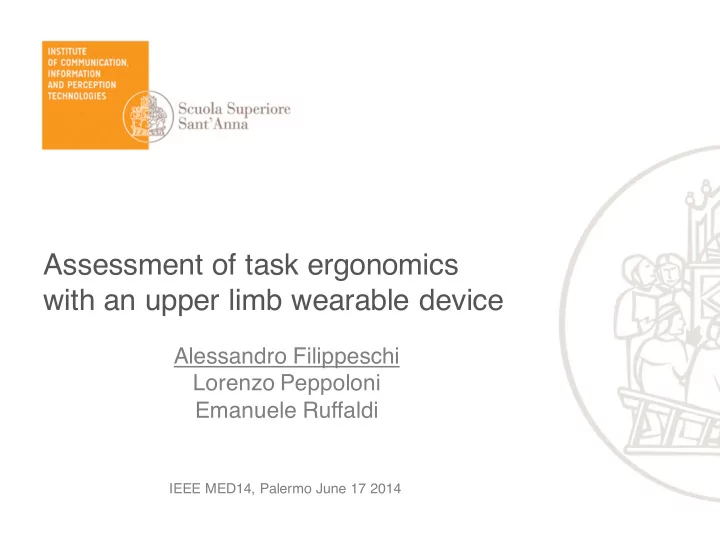

Assessment of task ergonomics with an upper limb wearable device Alessandro Filippeschi Lorenzo Peppoloni Emanuele Ruffaldi IEEE MED14, Palermo June 17 2014
Outline • Introduction • Objective • Ergonomic assessment • System • Motion and muscular activity tracking • Experiment • Results • Conclusion
Upper Limb Work-related Musculo Skeletal Disorders Thousands of worker suffering from work related upper limb musculo skeletal disordes (ULWMSD). In Italy, in 2007 ULWMSD were the 41,6% of all the work-related pathologies. • Wrist, elbow and shoulder are interested • Unstructured workplaces Ø do no allow us to quantitatively measure the worker activities in situated environments Ø cannot be easily modified to reduce potential causes of ULWMSD
Objective Develop a system for quantitative ergonomic assessment in unstructured environments • Selection of an ergonomic assessment method • Fully wearable capture device supporting • Motion tracking • Muscular activity tracking • Feature extraction for ergonomic assessment • Quantitative ergonomic assessment
Ergonomic assessment Several methods for ergonomic assessment cited by ISO 11228 and UNI-EN 1005 regulations Method Description Output Analysis of postures of different body segments; it also considers RULA Quantitative their frequency during a work shift Semi-detailed method that considers, in a simplified way, the same risk factors as the OCRA index. Exposure level is classified OCRA ckl Quantitative in the three-zone system. Applicable also to multitask repetitive jobs. Detailed method (for monotask handwork lasting almost 4 h per shift) mainly based on the analysis of frequency of actions (in HAL Quantitative relation to duty cycle) and of peak force; other main factors are generically considered. NIOSH Evaluation of the risks related to manual handling of load Quantitative Lifting Index during lifting tasks Analysis of postures of different body segments; it also OWAS considers their frequency during a work shift Quantitative
RULA • Assessment Workflow composed of joint angles measurements, force estimation and muscular activity triggers . • Selected as the easisest to implement among the ISO 11228 compliant
System Architecture Online, wearable Offline
Device Fully werable board supporting: • STM32F micro • 4 Invensense 9150 IMUs: Ø 3 axes accelerometer Ø 3 axes gyroscope Ø 3 axes magnetometer • 32 EMG channels • Maximum sampling frequencies Ø IMUs @ 100 Hz Ø EMG @ 500 Hz • On-board EMG filtering and feature calculation
Motion Tracking Kinematic model of the human upper limbs • 7 DoFs rigid bodies kinematic chain • Rooted in the chest • Shoulder abduction-adduction • Shoulder rotation • Shoulder flexion-extension • Elbow flexion-extension • Forearm pronation-supination • Wrist flexion - extension • Wrist abduction - adduction • IMUs associated to s# frames • Rigid transformation from parent link to sensor frame
Motion Tracking Unscented Kalman Filter for IMUs sensors fusion Filter State Process Model Measurements Model z s r off y s x s
Muscular activation 8 Channels EMG Bandpass Filter Raw Signals RMS Windows 128ms [20 - 200] Hz MVC Muscular activation triggers Muscular activity intensity measurement
Experimental Setup Method: • Participant: 1 healthy cashier • Equipment 1. board with 8 EMG, 4 IMUs 2. RGB-D sensor (MS Kinect) • Task: 2x10 minutes having either 1. random customer bag 2. known bag • Procedure 1. Familiarization 2. Calibration 3. Capture
Captured data and reconstruction EMG Bandpower and Posture Wrist motion Item List
Ergonomic assessment results RULA score Variables: • Shoulder angles • Elbow flexion • 4 7 1 Wrist angles • acceptable investigate changes Arm score further needed • Leg score • Load to be handled • Load static or dynamic flag • Neck flexion (here 0) • Neck bending flag • Trunk bending flag • Trunk flexion flag • Arm support flag • Leg support flag
Conclusion and future work Conclusion • Wearable system for ergonomic assessment • Acquisition and processing of sEMG signals • Acquisition and processing of motion data • Ergonomics score in ecological conditons Future Work • Extended assessment of the automatic RULA score • Online assessment
thank you! email: a.filippeschi@sssup.it
Recommend
More recommend